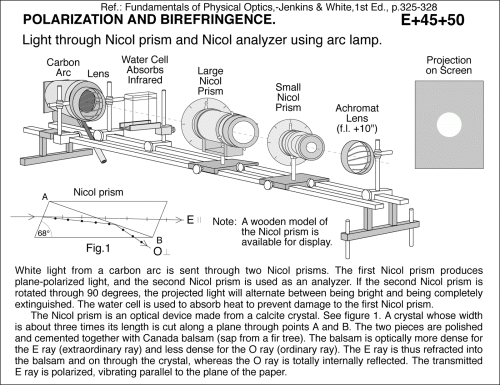Light through Nicol prism and Nicol analyzer, using arc lamp.
Primary tabs
White light from a carbon arc is sent through two Nicol prisms. The first Nicol prism produces plane-polarized light, and the second Nicol prism is used as an analyzer. If the second Nicol prism is rotated through 90 degrees, the projected light will alternate between being bright and being completely extinguished. The water cell is used to absorb heat to prevent damage to the first Nicol prism. The Nicol prism is an optical device made from a calcite crystal. See figure 1. A crystal whose width is about three times its length is cut along a plane through points A and B. The two pieces are polished and cemented together with Canada balsam (sap from a fir tree). The balsam is optically more dense for the E ray (extraordinary ray) and less dense for the O ray (ordinary ray). The E ray is thus refracted into the balsam and on through the crystal, whereas the O ray is totally internally reflected. The transmitted E ray is polarized, vibrating parallel to the plane of the paper. Light through Nicol prism and Nicol analyzer using arc lamp. Ref.: Fundamentals of Physical Optics,-Jenkins & White,1st Ed., p.325-328 Note: A wooden model of the Nicol prism is available for display.
UCB Index:
E+45+50
PIRA Index:
6H35.30
UCB Taxonomy:
Popularity:
Previous:
- Log in to post comments

